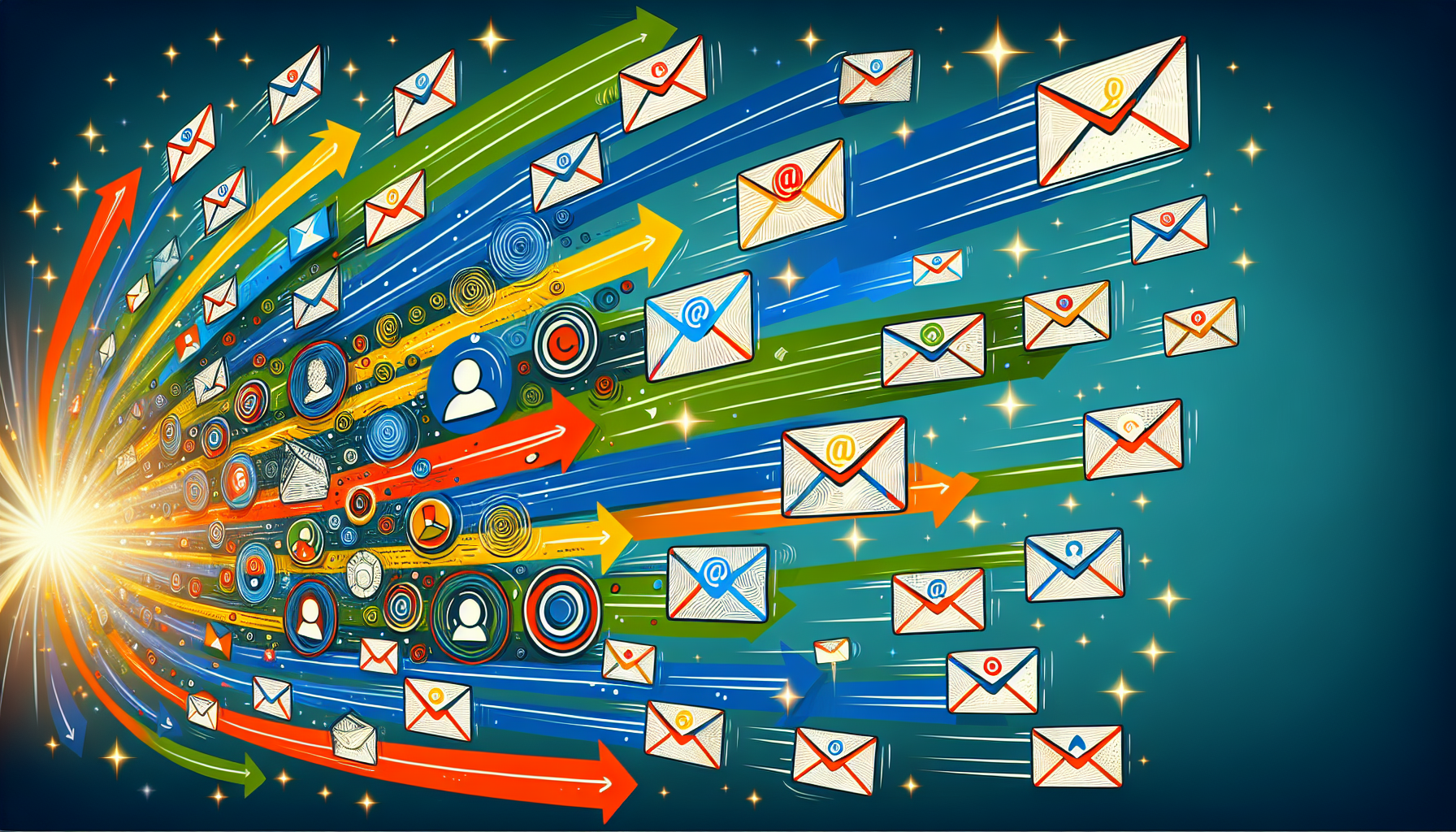
Unlocking the Secrets to Powerful Email Subject Lines
Struggling to grab your recipient’s attention in a congested inbox? You’re not alone. The key to boosting your email open rates lies in mastering the art of writing compelling email subject lines. This article unpacks proven tactics and examples to create “email subject line” that not only draws the eye but also persuades the reader to click through. Dive in to transition from overlooked to opened.
Key Takeaways
-
Email subject lines are critical – they can make or break your open rates!
-
Personalization and clarity are key – use the recipient’s name and keep it concise.
-
Avoid the spam folder at all costs by steering clear of trigger words and maintaining a professional tone!
Unlocking the Secrets to Powerful Email Subject Lines

Imagine you’re an email, sitting among a sea of other emails in an inbox. How do you stand out? How do you make your voice heard? The answer is simple: with a powerful subject line. It’s the first thing your audience sees and, as the saying goes, first impressions matter. A whopping 47% of email recipients decide whether to open an email based on the subject line alone. The stakes are high, and the role of email subject lines is paramount.
Crafting the perfect subject line is not just about being witty or clever; it’s about summarizing the email’s content succinctly and attracting the recipient’s attention to engage with the email. The ideal length of an email subject line should be no longer than 60 characters or approximately 6-8 words. Clear and descriptive subject lines that articulate the email content quickly and address the customer’s needs are the backbone of an effective email marketing strategy.
The Anatomy of a High-Performing Subject Line
Let’s dissect the anatomy of a high-performing subject line. On the surface, it may look like a simple string of words, but there’s much more beneath the surface. The recommended range for optimal subject line length is four to seven words or around 40 characters, particularly beneficial for mobile users where long subjects may be truncated.
The core of a successful subject line is its relevance and clarity. It should accurately reflect the email’s content to ensure they are inviting and to avoid being seen as spam, leading to better email deliverability. Some tips for creating effective subject lines include:
-
Including an offer, like a discount or freebie, in the subject line can be very effective at increasing the open rates of emails.
-
Keeping the subject line concise and to the point.
-
Using action words or creating a sense of urgency.
-
Personalizing the subject line to make it more engaging.
-
A/B testing different subject lines to see which ones perform the best.
Crafting Personalized Subject Lines
In the era of personalization, no one wants to feel like just another name on a list. Personalizing subject lines connects with the audience in a more human way and can significantly increase engagement by making each recipient feel unique and valued. Personalization can boost open rates by 10-14% across industries.
There are many techniques for personalizing email subject lines, including:
-
Using the recipient’s name
-
Referencing previous transactions
-
Incorporating location-specific details
-
Celebrating milestones
-
Addressing pain points directly
For example, Wag! personalizes its email subject lines by adding the owner’s dog’s name, contributing to a higher clickthrough rate.
Steering Clear of the Spam Folder
Crafting a compelling subject line is only half the battle. The other half is steering clear of the spam folder. Spam filters are likely to catch and filter emails with subject lines containing spam trigger words like ‘additional income’, ‘prize money up to [amount]’, ‘cash bonus’, or phrases related to free gifts. A professional tone in subject lines is ensured by avoiding the use of all caps, excessive exclamation points, or deceptive starters like ‘Re’, as they are considered spammy or misleading.
Improving email deliverability involves:
-
Removing bounced email addresses and those who have marked emails as spam from the subscriber list
-
Removing spam trigger words from the email body
-
Avoiding typos and repetitive phrases in subject lines
These actions can protect the sender’s reputation and decrease the likelihood of ending up in the spam folder.
Mastering Subject Line Styles for Maximum Impact
Now that we’ve cracked the code on the basics of subject lines, let’s delve deeper into the world of subject line styles. Email subject lines can be categorized into styles like:
-
Functional: straightforward about the email’s content
-
Teaser: create intrigue without revealing details
-
Benefit-driven: promise a specific value for the reader
Each style has its strengths and is best suited to different types of emails. Here are some examples:
-
Teaser subject lines: These are best used when the goal is to invoke curiosity and encourage the reader to discover more. For example, “You won’t believe what we have in store for you…”
-
Functional subject lines: These suit messages where clarity is important, such as important updates. For example, “Important: Changes to our service”
-
Benefit-driven subject lines: These are effective when highlighting offers, advantages, or solutions to recipients’ needs. For example, “Save 50% on your next purchase”
Injecting Humor with Funny Email Subject Lines
Humor can be a game-changer in email marketing. It lightens the mood, makes your emails stand out, and creates a memorable experience for your customers. Humor can be a successful tactic in email subject lines, making recipients more inclined to open the email as they are drawn to content that has the potential to make them laugh.
But while humor can be an excellent tool, it should be used wisely. It’s important to be respectful when using humor in email subject lines, avoiding jokes that could be perceived as rude, insensitive, or inappropriate. Like a well-seasoned dish, humor should be used in moderation.
Emojis can be effectively used in subject lines by creating a sense of fun or emphasizing a message without needing additional words, helping to ensure the tone of humor is conveyed correctly.
Creating Urgency Without the Hype
Creating a sense of urgency in your email subject lines can be a potent tool to prompt quick action from your subscribers. Action-oriented verbs and personalization with words like ‘you’ in subject lines can create a compelling sense of urgency that leads to immediate email opens.
Time-sensitive words such as:
-
‘urgent’
-
‘final’
-
‘ends tonight’
-
‘last chance’
or specific dates and times provide clear indications of urgency, prompting subscribers to act quickly to take advantage of offers. Incorporating scarcity or exclusivity elements, like ‘limited availability’ or personalized discounts, entices subscribers to act promptly to not miss out.
But keep in mind, while creating urgency is effective, it’s vital to avoid crafting subject lines that could be perceived as insincere or spammy by not exaggerating or misrepresenting the level of urgency.
The Art of Writing Catchy Email Subject Lines

As we navigate the vast sea of email marketing, let’s dive into the art of writing catchy email subject lines. The purpose of these subject lines is to generate excitement and entice readers to open the email. They are designed to capture attention and engage the audience.
Here are some tips for crafting effective subject lines:
-
Keep them short
-
Make sure they can be read entirely on mobile devices
-
Use all caps sparingly to avoid appearing spammy
-
Use action words to create a sense of urgency or curiosity
-
Personalize the subject line to make it more relevant to the recipient
-
Test different subject lines to see what works best for your audience
By following these tips, you can create subject lines that catch the eye and pique interest.
Originality in email subject lines sustains success with subscribers, engages first-time openers, and prevents boredom among long-term inactive subscribers. Creating amusing email subject lines can be achieved by:
-
combining two unrelated concepts for a surprising or unexpected message
-
being unexpectedly blunt, which contrasts with typical marketing language
-
asking a question in the subject line to resonate with an audience’s interests and incite curiosity, increasing the probability of the email being opened.
Leveraging Curiosity to Boost Open Rates
Curiosity, that irresistible urge to know more, can be a potent tool in the email marketer’s arsenal. Recipients’ curiosity is often driven by an information gap perceived between what they know and what they can learn from the email. Creating a successful curiosity subject line involves presenting a teaser that leads to resolution by reading the email’s content, thus bridging the information gap.
Posing a weird or unexpected question can successfully invoke curiosity and motivate readers to open the email for the answer. Subject lines that hint at valuable content within the email can effectively pique curiosity. Utilizing open-ended phrases or promises of interesting information in the subject line encourages higher email open rates.
Employing cliffhanger subject lines can leave recipients eager to discover more by reading the email. Using exclusivity in subject lines makes recipients feel special, builds loyalty, and increases engagement.
Using Questions to Engage and Intrigue
Asking a question in the email subject line is an effective strategy to engage readers and encourage them to seek answers within the email content. Posing a compelling question in the subject line can engage readers by tapping into relevant challenges or curiosities they have. Questions in email subject lines can engage readers by addressing something they may not have considered, making them eager to learn more.
Phrasing retargeting email subject lines as questions, such as ‘Ready to experience our new and improved products?’ can spark curiosity and engagement.
Designing Targeted Email Campaigns

In the world of email marketing, one size does not fit all. That’s where targeted email campaigns come into play. Including the recipient’s name or details relevant to them in email subject lines can boost open rates by 10-14% across industries. Using personalized emojis and referencing past user behavior in subject lines can create a stronger emotional connection and higher relevance.
Segmenting email lists allows the crafting of targeted subject lines that speak directly to different audience sub-groups, enhancing email relevance. Insights from A/B testing on segmented lists can reveal how demographics or user behaviors respond to specific subject line variations. Aligning subject lines with the recipient’s expressed interests or location data can significantly improve email engagement and open rates.
Targeted subject lines that are based on the recipient’s transaction history or retargeting efforts can drive repeat business and responsiveness.
Welcome Email Subject Lines: Making a Great First Impression
In the world of email marketing, first impressions are everything. Welcome email subject lines serve as a friendly introduction to your business for new subscribers and can help in maintaining engaged contacts. Crafting friendly welcome email subject lines, such as:
-
“We’re happy to have you”
-
“Welcome to our community”
-
“Thanks for joining us”
-
“Get ready for some great content”
can humanize a brand and make subscribers more likely to open the email.
Welcome email subject lines that suggest the beginning of a journey, such as ‘Welcome to [Brand Name]! Let’s get started,’ can motivate new subscribers to engage with your content. Personalizing welcome email subject lines by including the subscriber’s name, for instance, ‘Welcome, [Name]! Your first round of weekly quotes is here,’ can increase open rates by making the emails feel more tailored to the individual.
Offering exclusive deals in welcome email subject lines, like ‘You’re in! Your exclusive discount code is here,’ can create a sense of belonging and encourage subscribers to open emails.
Rekindling Interest with Re-engagement Subject Lines
Email marketing is not just about attracting new subscribers; it’s also about keeping the existing ones engaged. Re-engagement email subject lines are crucial to maintaining the quality of the email list and saving money in the long run. Some examples of personalized re-engagement subject lines are:
-
“Still interested in [Topic]? We’ve got updates!”
-
“We miss you! Come back for exclusive offers”
-
“It’s been a while! Here’s a special discount just for you”
These subject lines can reignite a subscriber’s interest by directly addressing their past interactions or preferences.
Offering a special deal or incentive in re-engagement subject lines, such as ‘It’s been a while; enjoy this exclusive offer!’ can motivate lapsed subscribers to re-engage with the brand. Asking for feedback through re-engagement subject lines, such as ‘Tell us what you think,’ can encourage subscribers to reconnect and share their thoughts, potentially reviving their interest.
Retargeting subject lines that address objections or offer incentives can bring subscribers back to the sales process and increase open rates. Understanding customer pain points can be used to create subject lines that address those pain points and offer solutions, which can entice subscribers to open the emails.
Re-engagement email subject lines that reference a subscriber’s absence, such as ‘We miss you! Here’s what you’ve missed,’ can remind inactive subscribers of the value they’re missing out on.
The Power of A/B Testing Your Email Subject Lines

The world of email marketing is not static; it’s a constant process of testing, learning, and improving. A/B testing subject lines is essential for discovering what content most appeals to your audience, leading to higher open rates. Email marketing strategies can be continuously enhanced through A/B testing, leading to better alignment with subscriber preferences and higher conversions.
Utilizing A/B testing offers a competitive advantage by allowing marketers to stay updated with customer preferences and market trends. Marketers can alleviate decision fatigue by using clear data from A/B tests to discern which subject lines resonate with audiences. Testing variations in subject line length and the invocation of emotional triggers aids in identifying the best approach for engaging your specific audience.
Adhering to A/B testing best practices, such as testing one variable at a time, selecting a representative sample size, and simultaneous testing ensures accuracy in results. To gather sufficient data for valid conclusions, A/B tests should be run for an appropriate length of time, which varies based on campaign goals and audience size.
Finding Your Brand Voice Through Testing
A/B testing is not just a tool for improvement; it’s a compass guiding you to find your brand’s voice. It can refine a brand’s voice by iterating with different tones, personalization, and keywords to see which resonates most with the audience. While testing for the right brand voice, it’s critical to keep the language, including the sense of urgency, consistent with the brand’s established voice to maintain authenticity and prevent alienation of subscribers.
Documenting the findings from A/B tests allows brands to develop a voice that appeals to their subscriber list and maintains a cohesive image across marketing campaigns. Effective subject lines often use emotional triggers, which require an understanding of the audience; testing various approaches can establish which triggers are most effective in engaging users.
Analyzing the Data: What Metrics to Look For
Testing is meaningless if you don’t know how to interpret the results. Key metrics such as open rates, click-through rates, and conversions are crucial in determining the winning variation of email subject lines. Statistical significance is an important aspect in analyzing A/B test results, ensuring that the differences observed are not due to random chance.
The significance of A/B test outcomes should be confirmed using statistical significance tools. Considering the context of A/B tests, such as current events or seasonality, is vital as these factors may affect the generalizability and relevance of the results. A/B test durations should be sufficient to collect meaningful data, with metrics like open rates sometimes showing clear winners within a few hours.
Analyzing engagement trends over time is important when looking at A/B testing data to identify long-term patterns, instead of relying on single tests. Secondary metrics such as bounce rates, unsubscribe rates, or time spent on the website provide a more comprehensive understanding of an email campaign’s performance.
Advanced Techniques for Crafting Great Email Subject Lines
As we round the corner on our journey through the world of email subject lines, let’s explore some advanced techniques. Embracing new technologies and understanding the psychology of your audience can elevate the effectiveness of your email subject lines.
Using AI for subject line personalization can increase engagement and open rates by presenting more targeted content.
The Role of Emojis in Modern Subject Lines
Emojis aren’t just for text messages anymore. They’ve found their way into the world of email marketing, adding a touch of color and personality to your subject lines. Using emojis in subject lines has been shown to surge open rates by as much as 45%.
However, as with all things, there’s a right way and a wrong way to use emojis. It’s essential to verify how emojis appear on different operating systems and email clients, as their rendering can differ significantly. Moreover, the use of emojis should align with your brand voice. Emojis can set a more casual and engaging tone, particularly effective in B2C communications, whereas a careful, event-specific, and conservative use is advised for audiences that might be older or expect a different tone.
Inappropriate or excessive use of emojis can lead to heightened complaint rates and can appear spammy or off-putting, demonstrating the need for relevance and moderation. For optimal mobile user engagement, ensure that email subject lines containing emojis are well-optimized to prevent being cut off and maintain visibility across devices.
Tapping Into Emotional Triggers
Email marketing is not just about presenting information; it’s about making a connection. Subject lines that tap into emotional triggers like:
-
fear
-
excitement
-
curiosity
-
urgency
-
exclusivity
Incorporating the keyword “blog post” can increase open rates.
Subject lines that tap into fears of missing out, like exclusive offers or limited-time deals, can significantly increase email open rates. Incorporating aspects of vanity in subject lines, such as the promise of increased peer recognition or avoidance of shame, can enhance engagement. Emotions often drive people’s decisions, making emotional subject lines powerful tools in influencing recipient behavior. Crafting a catchy email subject line is essential for capturing your audience’s attention.
A/B testing can help brands optimize their email subject lines by determining which emotional tones resonate best with their audience.
Email Subject Line Keywords That Work
Wielding the power of words is key to creating the best email subject lines, and email marketing subject lines are no exception. Crafting good subject lines, including a good email subject line with top keywords like “free delivery,” “available,” “new,” “alert,” “news,” “update,” “summer,” and “weekend,” as identified by Adestra, and “introducing,” “celebrate,” “buy,” “continues,” “get your,” and “wonderful” by Smart Insights has proved to be effective in boosting open rates.
Creating a sense of urgency or exclusivity with words like “limited time” and “exclusive offer,” adding social proof or testimonials, or using power words like “secret,” “spoiler,” or “hidden” can significantly enhance the appeal of email subject lines.
Maintaining straightforward, clear, and specific language in email subject lines, along with keywords relevant to the subscribers’ interests, can improve both email visibility in inbox searches and open rates.
Balancing Keyword Use with Creativity
While powerful keywords can boost the effectiveness of your email subject lines, it’s essential to balance keyword use with creativity. Crafting effective subject lines necessitates a blend of powerful keywords and creative expression to capture and maintain subscriber interest and curiosity.
Maintaining originality in subject lines is crucial to keep subscribers engaged and prevent them from perceiving the emails as monotonous over time. Subject line keyword checkers are instrumental in ensuring that email subject lines are optimized for maximum open rates by analyzing keyword effectiveness and helping to avoid the use of spam triggers.
Elevating Professional Communication with Expert Subject Lines
As we near the end of our journey, let’s take a moment to focus on the power of professionalism in email subject lines. Subject lines contribute to the development and maintenance of a professional brand image as they are a key element perceived by subscribers alongside the sender name and preview text.
Sales email subject lines can elevate professionalism by implying exclusivity or offering a unique proposition, compelling recipients to engage with the promotion. Professional cold email subject lines such as ‘New Sale: Save 25% on Everything!’ and ‘Last Chance to Sign Up for Our Free Webinar’ serve as successful examples that demonstrate respect and competence.
The Nuances of Networking and Meeting Request Subject Lines
Networking and meeting requests have their unique nuances when it comes to crafting personal email subject lines. To create a connection, personalize networking email subject lines using the recipient’s name or referencing a shared interest. Strengthen trust from the outset by referencing a mutual connection in the subject line.
Keep networking email subject lines between three to four words, or 17-40 characters, to grab attention while avoiding truncation. Reference a previous meeting or conversation in follow-up email subject lines to jog the recipient’s memory. Use follow-up subject lines like ‘Loved our chat at [event]’ to remind the recipient of the context and to foster continued conversation.
Acknowledge the recipient’s recent accomplishments in subject lines to show genuine interest and recognition. Propose potential collaboration through subject lines, such as ‘Exploring partnership on [project/idea]?’, to engage interest in professional relationships.
Summary
We’ve journeyed through the world of email subject lines, unlocking secrets, mastering styles, wielding the power of A/B testing, and exploring advanced techniques. We’ve seen how powerful keywords, combined with creativity, can create compelling subject lines. We’ve navigated the nuances of networking and meeting request subject lines and seen the importance of professionalism. Remember, crafting an effective email subject line is both an art and a science. It requires creativity, an understanding of your audience, and a willingness to test and iterate. Keep experimenting, keep learning, and you’ll see your open rates soar!
Frequently Asked Questions
What is a good subject line for an email?
Create a relevant subject line that gives a clear idea of the email content, and use action words like “urgent” or “limited time offer” to grab the recipient’s attention. Make your emails stand out!
What subject should I put in my email for a request?
Title your email with a compelling and urgent subject line that demands immediate attention, using keywords that indicate what you are asking for and why, such as “Action Requested” or “Need your input on Q3 sales report by Friday”. This will increase the chances of getting a prompt response. And remember, a direct subject line can be very effective, like “Request: West Water Project Update”.
What is a subject line in a letter?
A subject line in a letter states the topic or subject of the letter, like “Subject: Invoices.” This helps to eliminate the need for a clumsy introduction and clearly describes what the letter is about.
What do you put in the subject line of a greeting email?
In the subject line of a greeting email, you can use personalized greetings like “Hi [Name]”, “Hey [Prospect’s Name]!”, or “Happy [Day of Week]!” to make it warm and friendly. Remember to keep it engaging and personalized for the recipient.
What is the ideal length for an email subject line?
Keep your email subject line to around 6-8 words or 60 characters for maximum impact and engagement!
Are you interested in finding out more? Browse the rest of our blog for other marketing tips. If you’re ready to create your first email, survey, sign-up form, or landing page then register for a free trial to get the tools you need to build powerful marketing campaigns!
© 2024, VerticalResponse. All rights reserved.



